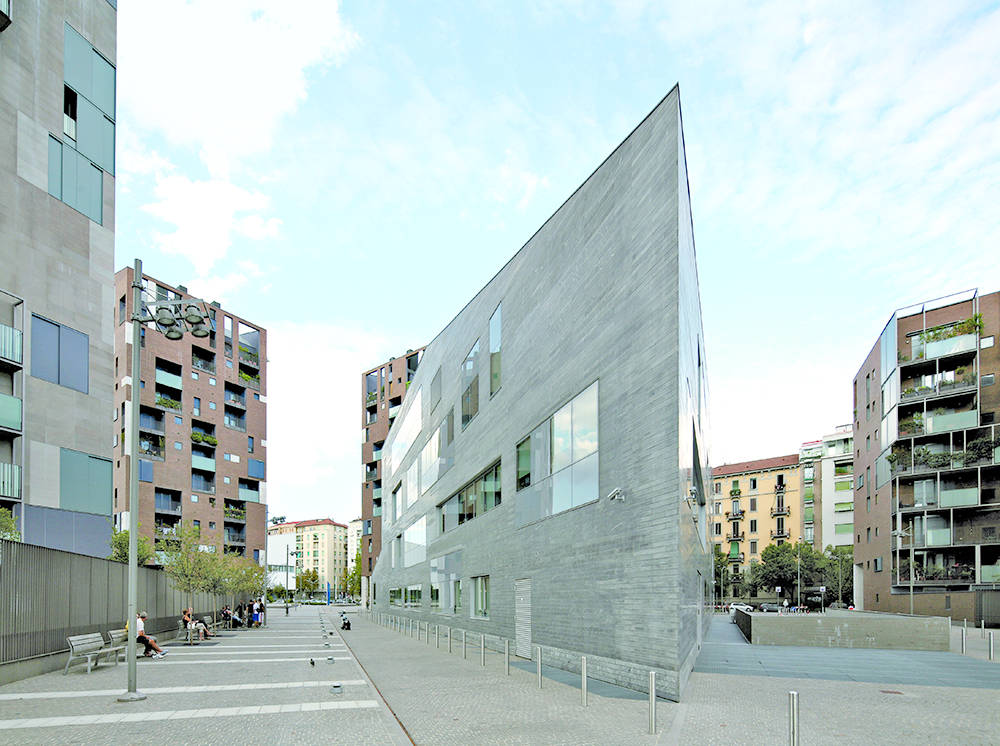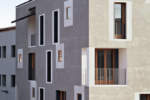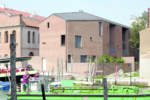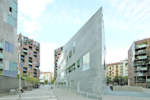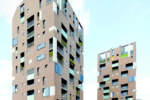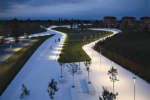location: Milan
year: 2012
Marco Casamonti: We did not decide to do a monographic issue on your work based on considerations of an “autarchic“ nature on Italian architectural culture, but rather because we are interested in a line of yours that manages to perceive an architectural object as a fragment of the urban fabric rather than as a piece of design. You have designed master plans and complex projects in Italy and throughout Europe, not just buildings, and you have always stressed the urban aspects rather than seeking the element of surprise or the spectacular aspect; we are interested, for this reason, in looking at your work from different, unexplored standpoints that do not limit it to that somewhat passé view of “cultured professionalism” linked to a uniquely Milanese tradition. Are there some critical readings of your work that you feel do not reflect your intentions or that you perceive as limiting?
Cino Zucchi: Criticism always needs simple categories, and often that of the cultural identity is one of the primary ones. I have never been able to stand a “genealogical” interpretation of architecture, and I don’t even like those expressions “Milanese school” or Roman school” that obsessed us for so long. Individual actions overcome those distinctions that are often mere conveniences and are applied ex post facto. Then there are people like Luigi Moretti who traveled in the opposite direction from Bramante, he ran away from Rome and came to Milan: is the Moretti in Corso Italia or via Corridoni “Milanese” or “Roman”? We don’t know, maybe it is neither one nor the other. Likewise, my education was not exactly linear. After attending the University of Milan for a year I went to the Massachusetts Institute of Technology, where I studied more math and physics than anything else. In those days the school of architecture at M.I.T. was marked by a cultural approach somewhat resembling Team Ten, and so I experiences the reasoning of De Carlo and Hertzberger filtered by the American climate.
After I returned to Italy I encountered a second cultural shock and ended up by behaving like a self-taught architect. I made some advances toward the field of architectural history, writing a book on the Milanese architecture of the 16th and 17th century, and another on the two minor figures of Italian rationalism, Asnago and Vender. I read a lot (I still belong to a class of age for which erudition is a value), and I have watched many past and contemporary architects at work. Regarding the “fathers”, I don’t feel particularly close to any genealogy; the condition of foundling is uncomfortable at times, but it has the advantage of circumventing the oedipal problems in which many of my peers found themselves.
In this sense, the most interesting architectural figures in Italy seem to me to be just the ones who stayed on the margins of the university bureaucracy, who didn’t try to gather a following, who weren’t tempted to engage in intellectual protectionism by appealing to a non-existent Italian “genius loci”.
Though I have always considered architecture a cultured activity, I maintain a direct attitude toward things, toward problems in their naked reality. I can’t stand it when erudition covers the miseries of practice. I am a true empiricist (I go in and measure things, I don’t believe any of the measurements written in the manuals), but unlike the younger generation, who view architecture as pure event, I think every discipline should engage in critical reflection every day on the “lasting” aspect of its instruments. I view culture as a gradual series of transplants or grafts of things partially known in different contexts, which acquire just for that reason unexpected meanings, sometimes capable of a “retroactive” action or a “kick” (I especially like this ballistic image). Thomas Jefferson, seeking classical architecture in the University of Virginia, seen through the eyes of Palladio, to save one out of two bricks, drew magnificent wavy walls that were stable by virtue of their geometry, worthy of a work of Eladio Dieste, but it is as if he forced us to rediscover Palladio himself through innocent eyes, stripping him of that mantle of erudition Trissino had draped him in.
I don’t like to make an excessively autobiographical reading of my work, but I could say that I myself am a strange graft between the direct, empirical approach deriving from my experience in the scientific environment in the U.S. and the culture and philological rigor of historical and typological research that marked Italian culture during the years of my training, “rediscovered” by choice and not by mechanical transmission.
Marco Casamonti: It’s true that sometimes the critics take a position and hold it so firmly and peremptorily that then it is hard to let go. Thinking of your work I am reminded of when Argan criticized Le Corbusier harshly in Casabella, accusing him of betraying his functionalist rigor with Ronchamp. In your case, they have all been so busy trying to explain why your Venetian house is Venetian – seen as an extraordinary and non natural event, in other words – that they completely misread your later works, in other locations and other contexts, where an entirely different attitude was necessary.
Cino Zucchi: An urban legend narrates how at the Newport Festival in 1965 Pete Seeger wanted to cut the microphone wire with an ax when Bob Dylan started to play Like a Rolling Stone on his electric guitar, scandalizing the purists of folk music. I don’t believe either in purity or in originality, but only in pertinence and character. An inherited design can be fresh if it is appropriate to the theme. I copied the white cornices of the windows of the Venice house from a project by Gabetti and Isola; but a month ago Kjetil T. Thorsen of Studio Snøhetta while we were on the jury of a prize said to me, with a smile: “see how many Zucchi’s windows… they all copied you”. I think ideas can be born at the same time in different places, and then migrate from one place to another unexpectedly: both formal and “theoretical” ideas.
Pier Paolo Tamburelli: In this connection, I think there are other contemporary architects who pursue studies similar to yours: Sergison Bates, Caruso St John, etc. Are there any affinities or is that just my impression?
Cino Zucchi: I have personal and cultural relations with both Caruso St John and Sergison Bates. I admire them greatly and I don’t think I am qualitatively at their level. With respect to them I consider myself perhaps more “eclectic”, more of a rover; they tend to pursue coherent, well-focused aims. They both talk about the limitation of language and its pertinence, and both are able to intentionally limit all the formal possibilities now possible through information technology to generate a landscape of the city that can consider itself to be a common, shared landscape. We could at this point discuss the theme of “reticence”, adding a few elements that indicate both knowledge of the code and a certain freedom in following it. In their architecture there is a strongly “dandified” quality; Baudelaire considered the dandy a sort of aesthete, with his obstinate pursuit of an ideal of purity. To return to my own attitude, I‘ll try to clarify it with analogies (obviously without any reference to the quality, but only to the way of viewing things): a director like Stanley Kubrick made movies that bore no resemblance to one another, from Lolita to A Clockwork Orange to 2001 Odyssey in Space to Barry Lyndon (I understand, for example, that in Barry Lyndon he used only candlelight or shot out of doors); the Beatles with their white album explored almost every genre of music, from folk to electronic to rock; Gustave Flaubert wrote Madame Bovary and Sentimental Education, but also Bouvard and Pecuchet or Salambo (to write it he studied for years about the Carthaginians!); and Franco Albini designed the Pirovano Hotel for Children, the Rinascente store in Rome, the offices of Snam at San Donato and the Tesoro di San Lorenzo in just a few years. In all these very different projects I see the intention to find the specific character of each work, rather than an expression of the character of the author. A short time ago, Antonio Monestiroli told me: “Cino, I can’t believe the author of the Venice house is the same one who did the offices of Assago, tell me it isn’t you!” Between the Headquarters of Salewa/Clockwork Orange and the Venice house/Barry Lyndon there is no formal relationship, but merely an attempt to find the right spaces and shapes for every “circumstance”, for every theme, for every specific context: a building-advertisement in an Alpine landscape or a housing project in the fabric of the Giudecca.
The Venice house is very similar in theme and language to the study you mentioned on the subject of “reticence”; however it is also true that in my production there are many things that differ from it: landscaping projects like the garden in San Donà de’ Piave, or projects that try to find expressive forms in relation to new materials and drywall technologies; but all are linked to the study of a “specific” truth, not driven by the mere desire to experiment with different languages.
In this sense the word I used before, “eclectic”, isn’t the right one, perhaps I should say “situationist”, freed of the ideological shadings it acquired in the Sixties – that might be a more suitable definition.
Pier Paolo Tamburelli: In my opinion, at the bottom of all this there is a desire to produce architecture for the background, architecture that is perceived as if out of focus, blurred, floating in memory in an uncertain position, like an image by Richter.
Marco Casamonti: I find that this ductility of the project, this contemporary intelligence, the idea that languages are a material to discover and use, belongs to a generation of intelligent, curious architects who study things in depth. Cino, like me and many others, has a very free attitude toward language that makes it difficult for critics to come to grips with his work: just when they try to read Cino’s work in a certain way, he designs the Automobile Museum in Turin, and they don't recognize him any more. For me the Venice house and the Automobile Museum are two utterly antithetical buildings, but they belong to the work of an architect who is aware of contemporary complexity, who changes the lens on his camera and looks at reality from a different angle depending on the occasion.
Pier Paolo Tamburelli: What I ask Cino is where his expressive range ends. I have the impression that the most absolute and peremptory precision is excluded from the very beginning. As if the shape had to lag a step behind, which seems to me like a good rule in general, but I wonder if this rule still applies, if there could not be some exceptions in which the shape can be more ambitious.
Cino Zucchi: The reason I suggested Pier Paolo today as an interlocutor is because I am very interested in his work and his theoretical reflections, which possess an important element of attraction for the younger generation. However, with respect to him, I feel much more skeptical about the possibility of a new “radical” position; I have a view of architecture that is on the whole kinder and more consoling (yesterday I was reading Adolf Behne, who unexpectedly quotes a phrase of Guyau “L’art c’est de la tendresse”.
If the pretense of minimalism and ascetism becomes something that denies habitability, the function of shelter and the sweetness of life, then they are no longer acceptable. The big question is another: what are the shapes today of purity and radicalism in a world distorted by the media? Media transmission makes everything false, even the true and the pure. So the problem of the younger generation is to find purity, a statement that doesn’t sound false the minute you put it out there and spread it around. But my vision of architecture is more “consoling”, like a favorite old song playing in the background of life. I would like to create architecture like what Belle and Sebastian, Natalie Merchant, Neko Case, A C Newman, the New Pornographers or the Shins do in music.
Pier Paolo Tamburelli: Architecture as consolation; I can’t say I find it exalting, but at least it seems to me a very honest way of intending one‘s work. There is a famous expression by Hannes Meyer who describes the work of the architect in a capitalist society as that of one who can no longer limit himself to designing "screens for the bourgeois theater”. For Hannes Meyer obviously this was the thing not to do, but probably it is a good description of was we, effectively, do every day. And perhaps to come right out and say it is already a sign of progress.
Marco Casamonti: It’s true that we also build screens or wings, but adaptability to the context is what matters. We have the ability to understand a level of complexity that the architects of the early modern period lacked. Cino’s work interests me as much as that of Herzog & de Meuron does, where I see every time the need to interpret a different reality, and find the proper setting for that “scene”.
What Cino did in the church at San Donato Milanese, or in Turin, and in the Venice house, shows an ability to read “urban facts” – to use one of Rossi’s expressions -, that stuns the critics, and this is the real richness of his work.
Pier Paolo Tamburelli: Cino is always very attentive, very understated but also very complicated.
Cino Zucchi: But even the mannerist is eclectic in a certain sense. I detest the 19th century and adore mannerism. My idol is Baldassarre Peruzzi, in his great understanding of the code and in his ability to apply it freely, without dogmatism. We are in the late Modern era: the ideological debate between the vertical window and the ribbon window, between Perret (who used air circulation as an supporting argument) and Le Corbusier (who used lighting technology) has been overcome. Now the ribbon window is a lexical element like any others; it has lost its aura of heralding a new architecture and is part of our ordinary equipment.
In this sense we are in an epoch of Mannerism of Modern. The modern code has already won, or has already become common: it’s not the battleground it was then, and we can use it with greater freedom. In physics, I also like the word “resilience”, that adds a little body to the term “ductility”, a little memory of the previous state.
Before, Pier Paolo quoted Gehrard Richter for his “blurry” portraits, but we could also include him in the category of the eclectics or situationists or mannerists, let’s say that they are people who don’t need to prove to themselves that they can be coherent in the language. We often read architecture in a form that is too artistic and too autobiographical. When I look at a new project I don’t see myself “continuing”, I only see a problem to solve. The building regulations have become a nightmare now: 80% of my time is not spent in abstract reasoning but is spent fitting a parking ramp and its air gratings around the elevator block. Even the critics read architecture in an excessively artistic manner, often without understanding the mechanisms of its production. It is only looking back at the sequence of projects that we can find some coherence, but this is not formal, it is just the realization of a sort of invisible gravitational pull of our character before the forks in the path of choices make us turn one way rather than another.
Marco Casamonti: But shouldn’t even critics change their way of reading architecture and its categories? Perhaps the classical method, centered on classifying and cataloguing formal aspects is starting to look frayed with respect a more contemporary approach.
Cino Zucchi: I’d like to get back for a second to the subject of architecture as “background” raised before by Pierpaolo. Walter Benjamin said that cinema and architecture are two mass arts, perceived “distractedly“. For me this was a fundamental insight into the utility of architecture. Unlike art, the architect can't select his public; we are forced to look not so much at the problem of the audience as at the criticism of our work by people whose values and tastes are very different from our own: architecture belongs to everyone, even private architecture, because it “contributes to the building” of the city.
But when it comes to judgment, what code and what values can be appealed to? To a “classicist” code based on convention, on the canon, on sharing, or to “romantic” values, based on the theme of expressive sincerity, individual sensation, originality? These two contradictory modes of interpretation are actually both found today in criticism and in the judgment of the people. Perhaps we need to understand the awareness of a code not in a regulatory and classicist sense but as the search for a minimum level of acceptability and sharing. Adolf Loos says that man is elegant when he disappears among the others (in western civilization).
In designing I start from a pragmatic and not semantic element of the architecture, how to solve the distribution problem. I’m sick of hearing all these architects who in order to build a little cottage first have to explain their “mission”, their “vision”, their world of tomorrow. In this sense, a certain “bourgeois discretion” can even be revolutionary, there are times when keeping quiet is a form of radicalism.
Pier Paolo Tamburelli: Here we can see a certain difference in age, because I already take this absolutely for granted. It seems ridiculous to me to work at a thesis, to write a manifesto, …
Cino Zucchi: Sure it is, but there is a lot of low level blob architecture around today, a lot of mannerist ecologism. Pier Paolo and some of his friends have performed an important role in this sense, reopening a line of communication with what I call the “architectural precedent” (not to call it “architectural history”, which is something else altogether) and the collective values.
Marco Casamonti: Getting back to your work, at one point Pier Paolo spoke of “blurred” backgrounds. With respect to the Venetian house which has a more peremptory composition, many of your later works are based on a multitude of color shadings, the windows are scattered with a studied randomness, as if everyone had built his or her own apartment as they wished, overlapping and layering.
Cino Zucchi: This search for a “natural look” - Horace Walpole is alleged to have said that of “Sharawaggi”, I used the name for my column in a women’s magazine – Asnago and Vender, for example, pursued it with vehemence, and they became a European cult just among the architects you mentioned before.
Pier Paolo Tamburelli: Cult for which you are highly responsible….
Cino Zucchi: Actually, I measured and went to check the original drawings of the façade of Piazza Velasca by Asnago & Vender; without any functional reason, the spacing between the windows is deliberately different, from one to another, even by just a few centimeters; this generates an effect that gives it a air of spontaneity, like those slight imperfections and asymmetries that we see in a human face reflected in the mirror. While Caccia Dominioni mixed up his window treatments on the façades according to what was almost an artistic process, Asnago and Vender try to make a common building, like the “Man without Quality” (it may not be a coincidence that Musil’s novel makes a reference to the house on the Michaelerplatz by Loos) and then they give it a little imperfection so as to age it and make the city “absorb” it.
Pier Paolo Tamburelli: Just because that, for me, is a given, that is that architecture lives in a distracted perception, my question was, actually: has this perception always been distracted or is there also the extremely rare case of a building that lives in an state of heightened perception, at least for most of its visitors? Is there a case in which this architecture that continuously produces background could become figure instead and is that why, for example, you design a “façade” and you make it symmetrical?
Cino Zucchi: The perception of the architecture, like that of the other arts, cannot be left to pure sensitivity: Paul Valéry said that lies halfway between the purely sensitive and the purely intelligible. There is a cognitive element and a sensitive or sensual one. Does this polarity between senses and intellect go through the entire history of art and its production? If for Durand and the Ecole de Beaux-Arts, architecture begins with geometrical axes that become a floor plan and then a cross section and then an elevation, there is an Anglo-Saxon tradition where the project tries to foresee the sensations that it will generate on the moving observer. I find that Kevin Lynch in “The View from the Road” is the heir of this “perceptive” tradition of the townscape.
The problem is perhaps how much the architect is or should be able to foresee the perceptive utilization. At one extreme you risk dissolving into a thousand views, with an entirely picturesque and caricatured of the city; at the other there is the pure typology. The famous layout of Palmanova looks strong when seen on Google, but actually generates a very mediocre city. In my urban design projects I often use techniques proper to townscaping. A certain degree of narrative quality, sometime a little bit of “cuteness” – like a bit of eyeliner on the eyelids – is not always deplorable. The use of color has always been considered a superstructure in architecture, but I am very attentive to the color. I have drawers full of color samples I paint myself in distemper, and I’m very proud of the faded cobalt blue of the shutters at Portello, which I achieved after endless tests.
At the other extreme is an “axonometric” view of the architectural object, like those of the covers on the volumes of San Rocco. Axonometry is the godly view, because God is everywhere, so that axonometry is the viewpoint of everyone and no one. The axonometric view privileges the abstract and conceptual image of architecture, the way that black and white do. But, possibly because of my own experiences, I place less trust in the ideal capacity of abstraction, of the “statement”: between ideology and empiricism I prefer the latter. I accept the “dirty”, pragmatic aspect of architecture and I don’t think that any supposed “coherence” can be used to justify the failure of most architecture to deal with the real world. Often it is just the difficulty of the context that gives form to the project. My house in Venice is possibly my most successful project just because the conditions were extremely difficult, and it required a tremendous effort to observe the context outside of the prejudices about a “postcard” Venice:
Pier Paolo Tamburelli: But isn’t there a risk that this attention to the surrounding conditions could end up by being a sort of camouflage? I think that the truly contextual projects are the ones that in the long run seem at first almost an independent element, and then permit both a clear and sharp reading and a blurry one, letting the passerby decide whether to pay attention or not. The early projects by Aldo Rossi have this extraordinary ability to stand out sharply but also to be forgotten or deformed in memory, for example the fountain of Serrate, or even the triangle of Polesello for Parliament, which in my opinion is beautiful just because it reacts to that place in such an incredibly precise way. It’s just a shame that Polesello went on making triangles for the rest of his life in places where they didn’t react to anything at all. In that particular case, with the minimum effort, the object was capable of reflecting all its complexity.
Cino Zucchi: I agree, analysis of the context has never generated a project. The data of the project are neither in the context nor in the program. It is necessary to formulate a hypothesis, I would almost say a “prejudice”, that is then immediately tested with the data or with the context. That is what Charles Sanders Peirce called “abduction”, the invention of a model verified after the fact but not foreseeable on the basis of a pure examination of the data.
In that sense, this is what unifies the American scientific experience and the Milanese tradition of cultured professionalism. The generation of Magistretti, of Caccia Dominioni, of Rogers or even of Portaluppi showed a greater empiricism than that of Aldo Rossi and Giorgio Grassi, who were their students, after all. Unlike rationalism, empiricism is capable of learning from its mistakes through a mechanism of retroaction.
Marco Casamonti: You said something before about sweetness, but then you have to explain the Salewa project in Bolzano. I see in most of your work the blurry wings and all those themes we have been talking about, but the peremptory nature of the Bolzano project seems quite different from your other architectures.
Cino Zucchi: I don’t agree, because in my opinion the Salewa is an extremely inviting project on the side that looks toward the city and on the inside: it succeeds in creating a new place, and one that gets a lot of visitors, where the users of the bistrot can watch the rock climbing competitions in the large gym that opens to the view of the fields and mountains. On the side toward the motorway it is in an architecture symbolic of a company devoted to Alpine sports, but the particular color of its exterior makes it a chameleon in the landscape.
At some times of day and from certain angles it completely disappears against the background of the mountains. The gray-blue of its exterior aspect is not its color, but the walls seen through moist air, like the background of the Virgin of the Rocks by Leonardo.
Simultaneous resolution of the theme of “brand architecture” and landscape is almost always impossible, as a rule. But at the Salewa I think that we of CZA and the Parks, coauthors of the project, were pretty successful.
Marco Casamonti: I think there are authors who have a very high percentage of failure and just by luck once in awhile manage to do something really good. Then there are other authors, who are the ones like you and the people that interest us, who actually never do bad work: in the continuity of their work you recognize coherence of thought and creativity. All your works (especially the built ones) have an awareness and a constancy of output that is more important than the peaks.
You are not greatly interested in calligraphy but you seem much more interested in the content, the text and the context.
Cino Zucchi: I think at the beginning the project has to be “formless”; you must suspend your “taste” faculty for awhile because it is the selective element, and the first idea has to be generated outside of taste. Taste doesn’t create but only selects. I think that you find ideas by chance and you keep them by choice; the process moves quickly between invention and refinement, in a way that is neither deductive nor inductive. When I speak of “taste” I am thinking of the 18th century meaning of the word that includes sensitivity, but also figurative culture. But the resonances I hear in the shape are not the same as those of a twenty year old. For me those resonances are part of the meaning.
In the end, I feel like a “pop” architect because I consider the jingle the highest form of music, and I adore movies like Inglorious Basterds by Quentin Tarantino which are at the same time sophisticated and popular. I’ve heard that Ejzenštejn, the great Russian director, envied Walt Disney, and wrote an essay about him because he considered him a true popular spirit.
I seek salvation in this world and nowhere else, and I am fascinated by the fact that architecture can exist simultaneously as high culture and daily life. As Josef Frank said in 1931 polemicizing with the abstract formalism of the time: “This the reason why the new architecture will be born out of all the bad taste of our time, its chaos, its variety and sentimentality, from everything that is alive and felt: at last it will be art ‘by’ the people, and not ‘for’ the people.”


